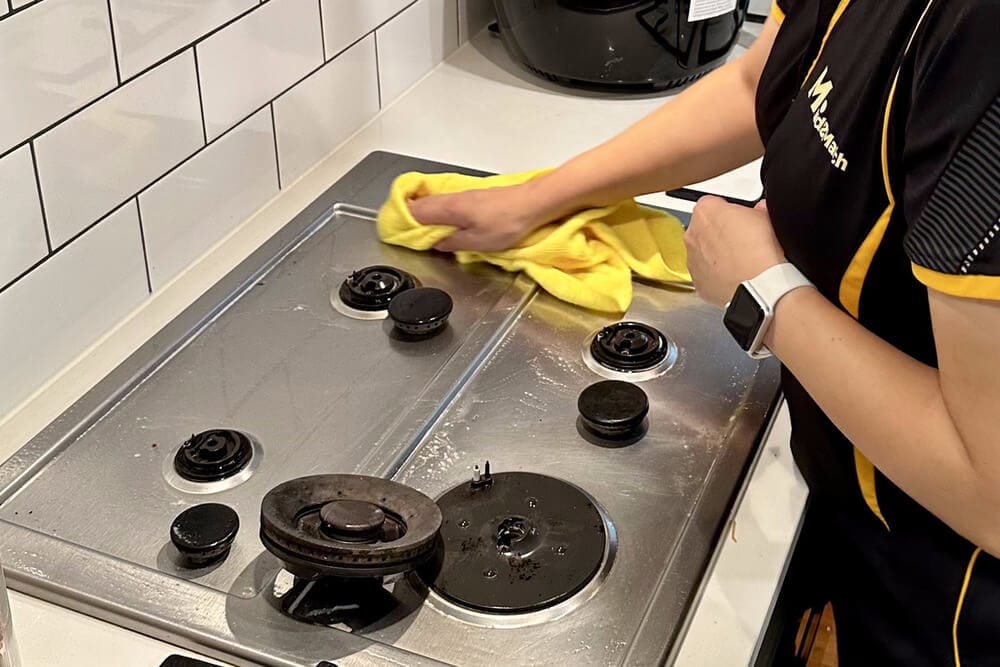Stainless steel is a classic material for many kitchen appliances – including your stove.
A stainless steel cooktop looks sleek and timeless, but smudges, fingerprints, and stains can easily tarnish the surface. They’re not difficult to clean but require regular maintenance to keep that distinctive sheen.
How to clean a stainless steel stove top? Do daily cleaning with detergent and water, or vinegar and water. You can deep clean with a baking soda paste and some elbow grease.
Cooktops are such high-traffic areas, so your top priority is keeping them clean. Here’s a range (ha!) of methods for maintaining your stainless steel stove.
About Your Stainless Steel Cooktop
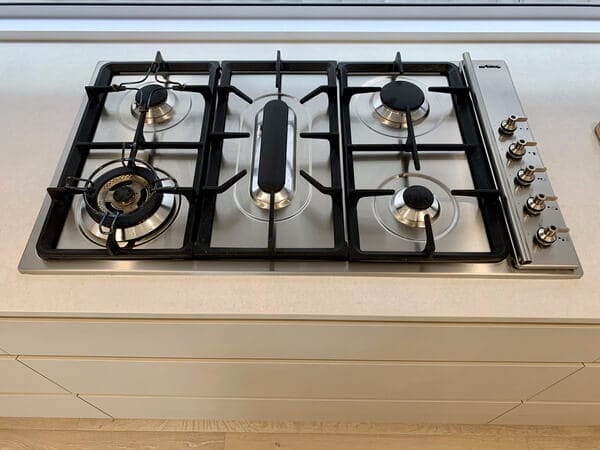
Stainless steel stoves are typically gas-type stoves – so they have gas burners protruding from the surface, with cast iron stove grates on top.
The grates prevent direct contact between your cookware and the burners, minimising the risk of damage.
Stainless steel is a very durable material, made from an iron and chromium alloy. It’s highly resistant to rust and non-porous, which is why you see many stainless steel appliances.
Are there advantages to stainless steel cooktops? Yes – primarily, that they’re very long-wearing and durable. The non-porous surface makes them very hygienic, and there’s no risk of shattering, unlike a glass cooktop.
However, stainless steel shows stains, fingerprints, and smudges very easily. The cooktop surface may also turn hot when cooking and takes a while to cool.
Since it’s typically a gas stove, you have the additional cost of gas and the safety risk.
How Often to Clean a Stainless Steel Cooktop
Regular cleaning and maintenance keep your stainless steel cooktop hygienic and safe. It prevents the build-up of residue that could lead to mould or a fire risk.
Immediately clean up any stains or burnt residue once the stove has cooled down.
Wipe the stainless steel surface after use or at the end of the day.
Deep clean the stove top once a week, from the cooking surface to the knobs.
If you’d love to treat yourself to a kitchen that sparkles from top to bottom, go ahead and book a professional home cleaning service!
Before Cleaning Stainless Steel Cooktops
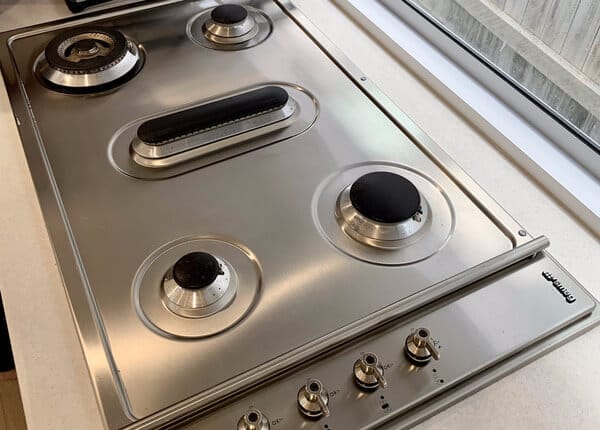
Before starting the cleaning process, ensure the stove is switched off and all the elements have cooled completely. This minimises the risk of injury or burnt cleaning products.
Remove any cookware and ready your cleaning supplies. You can check your owner’s manual for any specific cleaning instructions.
What to use when cleaning a stainless steel stove top
If you’re looking for a stainless steel stove top cleaner, you can either go homemade or use a commercial product.
When cleaning stainless steel, some natural cleaners include:
- Dish detergent and water
- Baking soda paste
- White vinegar and water
For a commercial stainless steel cleaner, make sure it’s safe for cooking and food surfaces.
Opt for microfibre cloths and soft sponges so you don’t scratch the surface. Paper towels are acceptable but might leave residue or fuzz.
What not to use when cleaning a stainless steel stove top
Avoid any products containing bleach, ammonia, or chlorine since these harsh chemicals can corrode the material. Do not use glass cleaners as these aren’t formulated for stainless steel.
Stay away from any abrasive cleaners which could scratch the surface. At most, use a baking soda paste, which isn’t gritty enough to cause scratching.
Skip any abrasive materials as well, such as steel brushes or steel wool. These will damage the finish of your appliance, making it susceptible to rust or stains.
Daily Stainless Stove Top Cleaning
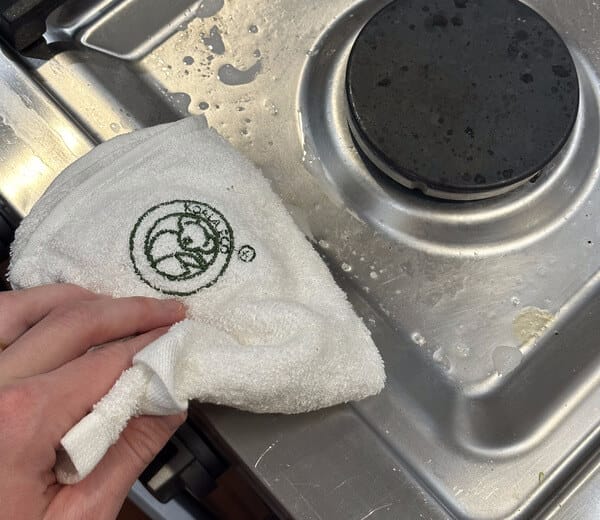
After cooking (or at the end of the day), you can quickly wipe your stove clean and dry. This minimises the build-up of grease and food residue.
Simply mix a few drops of dish detergent in warm water, and use it to dampen a microfibre cloth. Wipe the stainless steel surface, making sure to go with the grain to avoid smudge marks.
Use a dry cloth afterwards to remove excess moisture and prevent water spots.
Alternatively, mix equal parts white vinegar and warm water in a spray bottle. Apply the cleaning solution to the stainless cooktop, then wipe it off immediately with a microfibre cleaning cloth.
Do not let vinegar sit too long on the surface, as it could etch the material.
How to Deep Clean a Stainless Steel Stove Top
Again, let all the elements of your cooktop cool down before deep cleaning! You can disconnect the gas temporarily if it’s not inconvenient.
Check the owner’s manual for any removable parts and how to detach them from your stove. This will typically include the stove grates and burner caps.
To clean a stainless steel stovetop without scratching, always wipe in the direction of the grain (horizontal or vertical) and use appropriate cleaning products.
Cleaning the cooktop surface
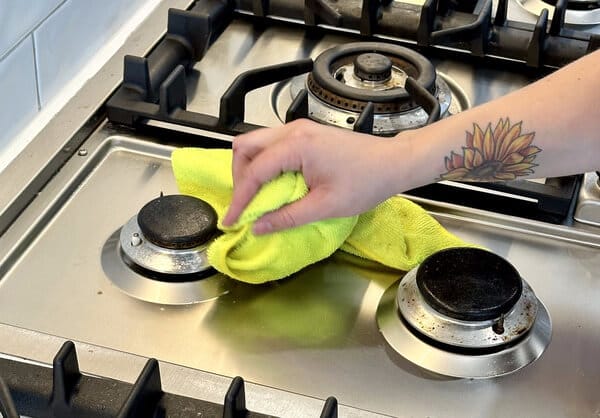
Use a damp, soft cloth to remove surface dirt, crumbs, and other food residues.
Mix equal parts white vinegar and water in a spray bottle, then lightly spritz the stove top. Wipe away immediately with a damp cloth.
If you’re using a stainless cleaner, follow the instructions for cleaning. Wipe the cooktop with a damp cloth to rinse, then follow with a soft cloth to dry.
Cleaning the burner caps and rings
For removable caps and rings, take them off when they’re cool. Bring them to the kitchen sink and wash them with some anti-grease dish detergent and hot water.
If there are stubborn stains, you can soak them in hot, soapy water for up to 5 minutes to loosen the dirt and grime.
Scrub them with a non-abrasive sponge, then thoroughly dry them with a lint-free cloth.
Cleaning the stove grates
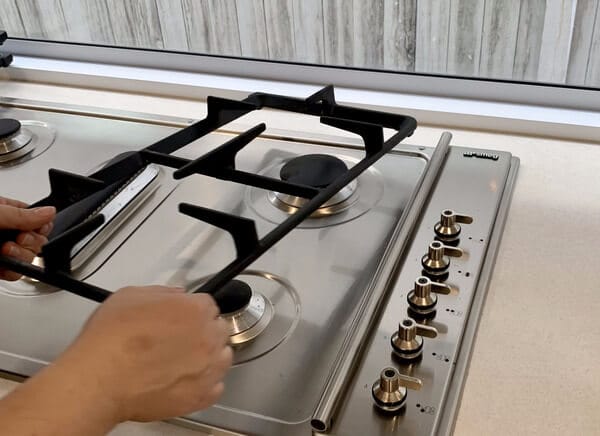
A modern gas stove will come with porcelain-enamelled cast iron grates to keep your cookware from touching the burners.
Cleaning stove top grates is fairly straightforward – you can simply soak them in hot, soapy water and scrub them with a stiff nylon brush or cleaning pad.
Alternatively, use a thin paste of baking soda and water and let it sit for up to 30 minutes. Use a damp microfibre cloth to scrub the grates then rinse them thoroughly.
Wipe the grates completely dry afterwards.
Cleaning the stove exterior
Make sure to clean the rest of your stainless steel cooktop, including the exterior and the knobs!
You can use the same water and vinegar cleaning solution, then wipe the components dry with a soft cloth. Make sure to get into all the nooks and crannies.
How to Remove Stains from a Stainless Steel Stove Top
Despite the name, cooking can still cause stains on stainless steel!
Whether your pasta has boiled over or you’ve knocked something onto the cooktop, it’s essential you tackle stains ASAP.
Otherwise, you could bake the stain onto the surface and damage the material.
Removing food spills
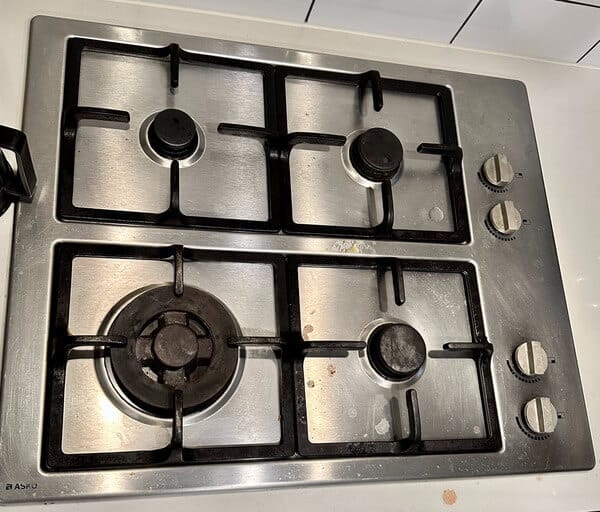
Most food spills can be cleaned with some vinegar and elbow grease. Mix equal parts vinegar and warm water in a spray bottle.
Spray the affected area with the cleaning solution and let it sit for a few minutes to loosen the residue.
Use a non-abrasive sponge or soft cloth to gently scrub the stains off. Follow with a damp cloth to remove any remaining residue, then dry the stove top.
Removing burnt-on grease
Baking soda is great for tackling grease stains on many surfaces. Make a paste using 3 parts baking soda and one part water.
A few drops of anti-grease dish detergent are optional, but add an extra cleaning punch!
Use a soft sponge to apply the paste to the stain, then let it sit for a few minutes. Take a damp microfibre cloth or non-abrasive sponge and gently scrub the stain in the direction of the grain.
Follow with another damp microfibre cloth to rinse off the residue, then wipe with a dry towel.
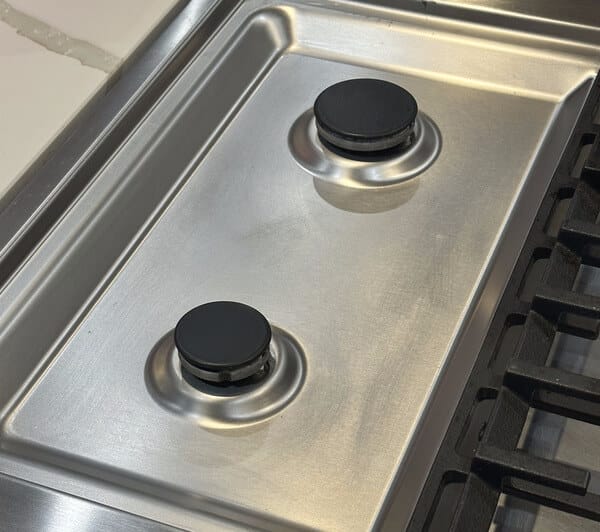
Removing burn marks
Try mixing some vinegar in hot water, and carefully pour it onto the burnt area. Then use a cooktop cleaning pad to carefully scrub the marks away.
If that doesn’t work, you can use the baking soda paste with dish detergent. Let it sit for about an hour, then use a cleaning pad or sponge to scrub off the burn marks.
How to Remove Scratches from a Stainless Steel Stove Top
Note that you’ll only be able to tackle mild or superficial scratches at home.
You can try a thin paste of baking soda to buff the scratch off, then wipe the residue away with a damp microfibre cloth.
Alternatively, use a powder-based stainless steel cleaner such as Bar Keepers Friend Powder Cleanser.
Anything deeper may require a repair kit from your manufacturer or a professional job.
How to Polish a Stainless Steel Cooktop
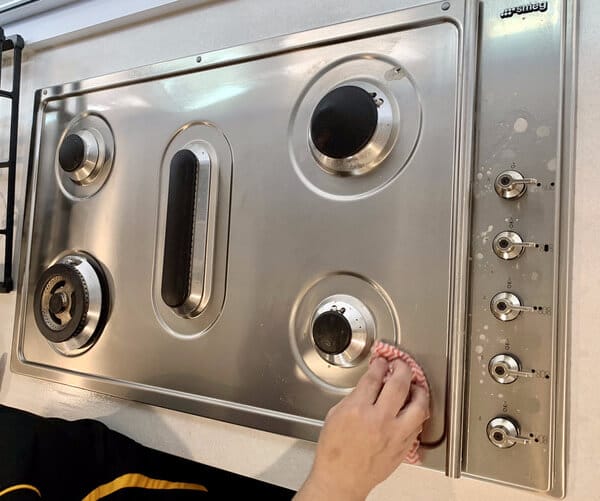
Polishing a stainless steel cooktop is an optional step, given how often you use your appliance. But it’s a great way to restore some shine and add a protective layer against smudges and corrosion.
For a stainless steel cooktop, use olive oil so you don’t contaminate your food. Commercial polishing paste is better for other appliances or decorative surfaces.
Apply a few drops of olive oil to a soft cloth, then use it to rub the surface. Always follow the direction of the grain to prevent streaking.
Buff with a clean, dry cloth to remove excess oil and bring out the shine.
NOTE: Avoid using a paper towel to polish, as it could leave fuzzy residue or streaks.
Tips for Cleaning Your Stainless Steel Cooktop
Here are a few more tips and answers about cleaning and maintaining your stainless steel cooktop!
What is the best cleaner for a stainless steel stove top?
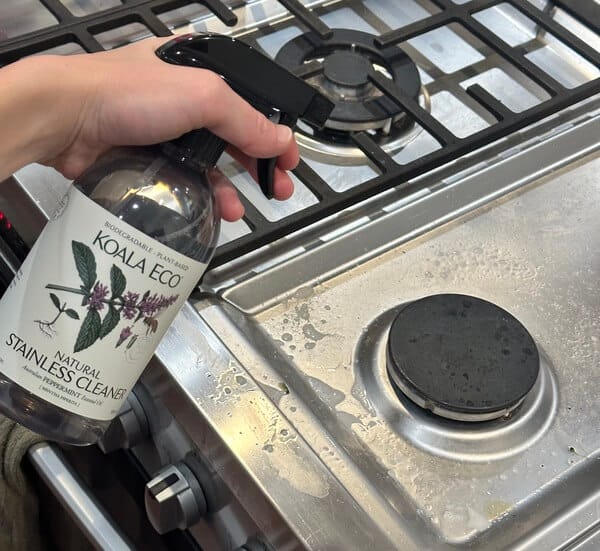
You can clean your stove top and most other stainless steel surfaces with mild dish soap and water, or a vinegar mixture!
Alternatively, there are dedicated stainless steel cleaners available in stores.
One great product is the eco-friendly and septic-safe Koala Eco Stainless Cleaner. It contains biodegradable plant-based ingredients that remove bacteria and disinfect the surface – plus it smells fantastic.
FYI – best paired with their organic bamboo cleaning cloths, perfect for cleaning stainless steel!
How do I get brown stains off my stainless steel cooktop?
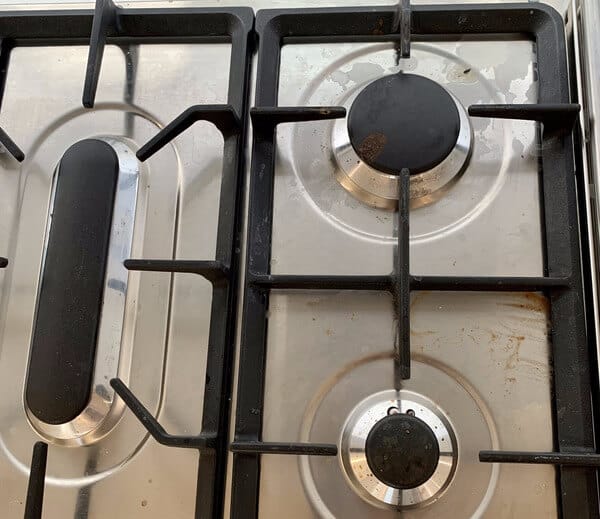
Brown stains and discolouration typically come from food or grease residue. Simply use the baking soda paste and a microfibre cloth to remove the stain.
Rinse with a damp sponge or cloth, then dry thoroughly.
Is vinegar safe for stainless steel?
Yes – with a caveat! Vinegar is safe for cleaning a stainless steel cooktop and other surfaces, but you shouldn’t let it sit on the material for more than a few minutes. The acid in vinegar can etch the surface.
If in doubt, test your cleaning solution on an inconspicuous area first.
How to prevent scratches on a stainless steel cooktop
Do not drag your cookware (especially heavy ones like cast iron pans) – lift and set down carefully.
Avoid using any abrasive materials or products when cleaning.

